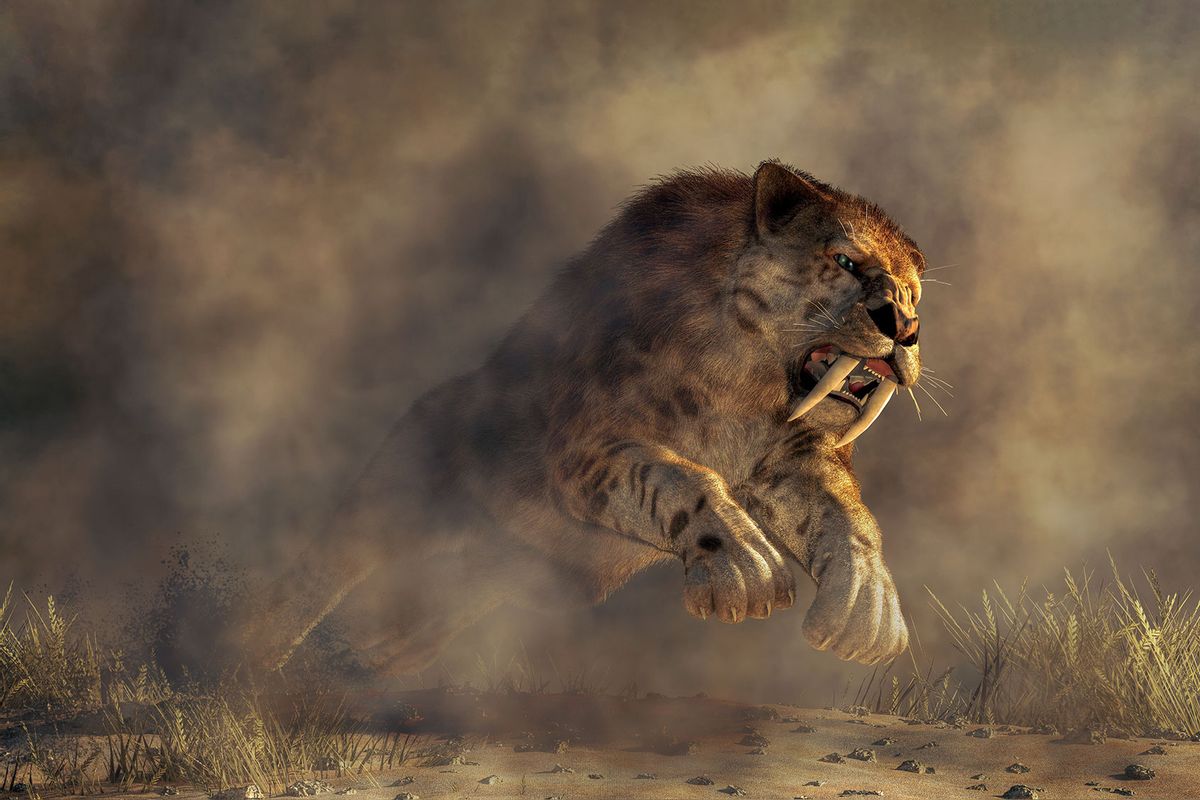About 13,000 years ago, flora and fauna began disappearing from the fossil record in the region of modern-day Southern California in a mass extinction. New research indicates a familiar culprit played a bigger role in the destruction of the ecosystem than some once thought: humans.
Using carbon records for plants, animals and charcoal accumulation in Southern California and matching them with projections of what human activity was like in the area, researchers found the mass extinction of nearly all species they studied — including sabre-toothed cats, the dire wolf and bison. The extinctions corresponded to a period of "unprecedented fire activity," following human arrival on the continent that suggests these early communities were the "primary cause of the state shift and resulting extinctions," according to the paper published today in Science.
"The human population increases, they start to kill off the herbivores, the fuel loads start to increase, there's a big drought and you're suddenly starting to get these massive fires that are burning down the forests," said study author F. Robin O'Keefe, Ph.D., an evolutionary biology associate professor at Marshall University. "Once those forests are cleared out, the chaparral taxa comes in," he said, referring to shrubland plants found throughout California.
Before the Holocene period, which started about 12,000 years ago and extends to today, present-day Southern California was a lot wetter and cooler, with more woodland trees — kind of like Oregon. During this Pleistocene period, the sea level was 100 meters lower, with much more land exposed on the continental shelf near the Los Angeles Basin.
The fact that the evidence of fires had previously been low even in times of drought suggests human-made rather than wildfires were accelerating the ecosystem shift.
Ice sheets had been melting across the globe due to global warming, which also made lands drier and hotter. According to the study, this drying occurred between 16,000 and 13,000 years ago, followed by the destruction of forests and the replacement of trees like oaks and junipers with more fire-resistant plants like pines. The land became the chaparral landscape Southern California still has today and humans helped accelerate this drastic ecosystem change, the study suggests.
Previously, evidence of fires and the carbon they emitted had been low, but it increased 30-fold when humans arrived, according to the study. The fact that the evidence of fires had previously been low even in times of drought suggests human-made rather than wildfires were accelerating the ecosystem shift, though whether humans "lit the match, we don't know," O'Keefe said. Still, the magnitude of fires was "unprecedented in the 33,000-year record," the authors wrote.
"This suggests that the decline of megafauna was not solely a consequence of excessive hunting."
"The extinction is largely due to humans, but it's through a lot of direct and indirect effects," O'Keefe said. "Climate change was important, too, and all of these things play together to create this nonlinear event: this catastrophic fire event."
Anikó Tóth, Ph.D., a macroecologist at the University of New South Wales, who was not involved in the study, agreed that the data points to "the potential for humans to have orchestrated significant ecological transformations during that period."
"This suggests that the decline of megafauna was not solely a consequence of excessive hunting, the conventional suspect in studies linking human activity to megafaunal extinctions," Tóth told Salon in an email.
Scientists today warn that exceeding 1.5 degrees of global warming would trigger multiple "tipping points," that lead to irreversible changes in climate systems that have significant effects on life as we know it.
This year's record temperatures and widespread wildfires are evidence that we are fast approaching said tipping points. Torched landscapes are already unable to return to their previous states because "the climate is not suitable for the vegetation that used to grow there," said Anthony D. Barnosky, Ph.D., a paleoecologist and professor emeritus at the University of California.
"This study is a great example of how we can use the past to portend the future," Barnosky, who was not involved in the research, told Salon in an email. "And what we are seeing today — increasing human pressures combined with and actually causing climate change — is like this lesson from the past on steroids."
We need your help to stay independent
There are things we can do to prevent another catastrophic change, including slowing climate change by reducing emissions and transitioning to renewable energy, O'Keefe said. "If we stop doing that and if it stops getting warmer, that takes away some of the key drivers of extinction," he added.
"We have knowledge people 13,000 years ago didn't have," O'keefe said. "We can choose our future — but if we do business as usual, it's going to choose us. This is a cautionary tale."
Read more
on climate change



Shares